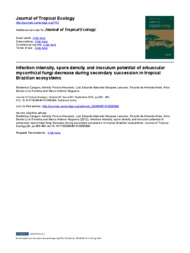Infection intensity, spore density and inoculum potential of arbuscular mycorrhizal fungi decrease during secondary succession in tropical Brazilian ecosystems.
Infection intensity, spore density and inoculum potential of arbuscular mycorrhizal fungi decrease during secondary succession in tropical Brazilian ecosystems.
Autoria: ZANGARO, W.; ANSANELO, A. P.; LESCANO, L. E. A. M.; ALVES, R. de A.; RONDINA, A. B. L.; NOGUEIRA, M. A.
Resumo: Little is known about the relationship involving arbuscular mycorrhizal (AM) fungi and functional groups of plants that characterize different phases of tropical succession.We appraised the AM infection intensity of root cortex and spore density in the soil in sites over tropical successional gradients (grassland, secondary forest and mature forest) for several years in Araucaria,Atlantic and Pantanal ecosystems in Brazil. The intensity ofAMinfection decreasedwith advancing successional stages in all ecosystems and it was around 60–80% in early stages of succession, 37–56% in secondary forests and 19–29% in mature forests. Similarly, the AM spore number also decreased with advancing succession and was the highest in early stages (73–123 g?1), intermediate in secondary forests (32–54 g?1) and lowest in the mature forests (10–23 g?1). To verify whether such reductions influenced the potential of AM inoculum in soil, seedlings of Heliocarpus popayanensis (Malvaceae) were grown as test plants in soils obtained from five grasslands, five young secondary forests, and five mature forests in the Atlantic ecosystem. The soil inocula from the grasslands and secondary forests were 7.6 and 5.7 times more effective in stimulating seedling growth than inocula from the mature forests, respectively. Our results show that plant species in grasslands and young secondary forests stimulate the multiplication of AM fungi, leading to a higher potential of the AM inoculum. In later-successional stages, plant investment in AM fungi decreases and the potential of the AM inoculum is also reduced.
Ano de publicação: 2012
Tipo de publicação: Artigo de periódico
Unidade: Embrapa Soja
Palavras-chave: Fertilidade do solo, Soil fertility
Observações
1 - Por padrão são exibidas publicações dos últimos 20 anos. Para encontrar publicações mais antigas, configure o filtro ano de publicação, colocando o ano a partir do qual você deseja encontrar publicações. O filtro está na coluna da esquerda na busca acima.
2 - Para ler algumas publicações da Embrapa (apenas as que estão em formato ePub), é necessário ter, no celular ou computador, um desses softwares gratuitos. Sistemas Android: Google Play Livros; IOS: iBooks; Windows e Linux: software Calibre.
Acesse outras publicações
Acesse a Base de Dados da Pesquisa Agropecuária (BDPA) para consultar o acervo completo das bibliotecas da Embrapa.

